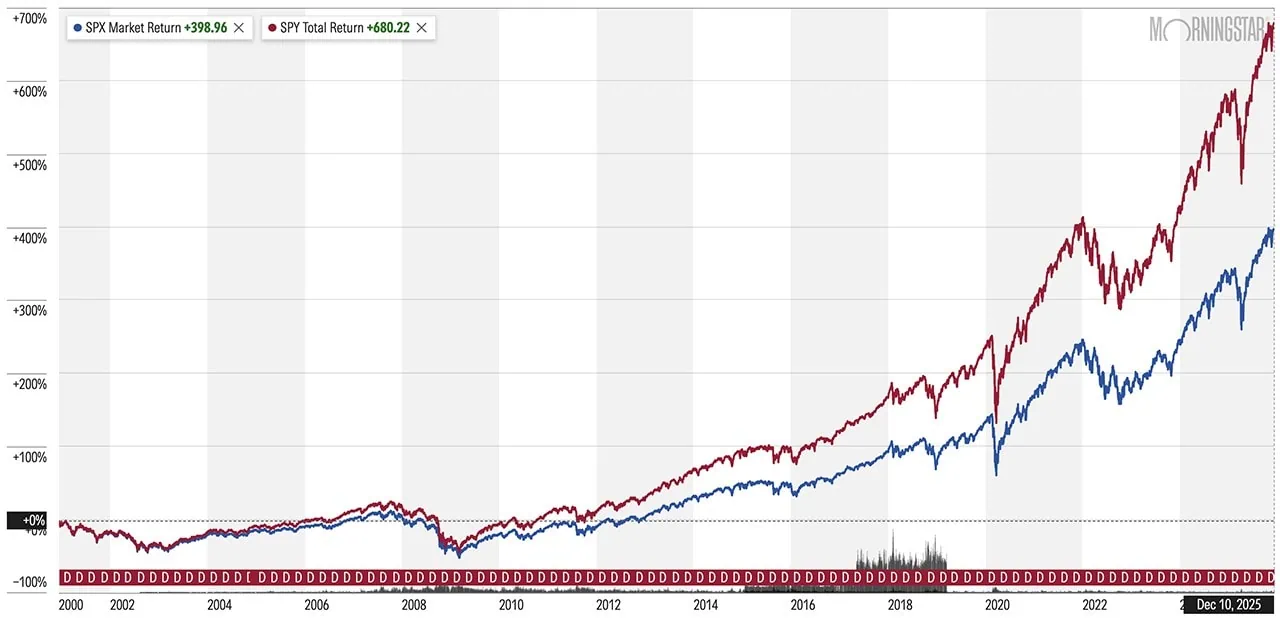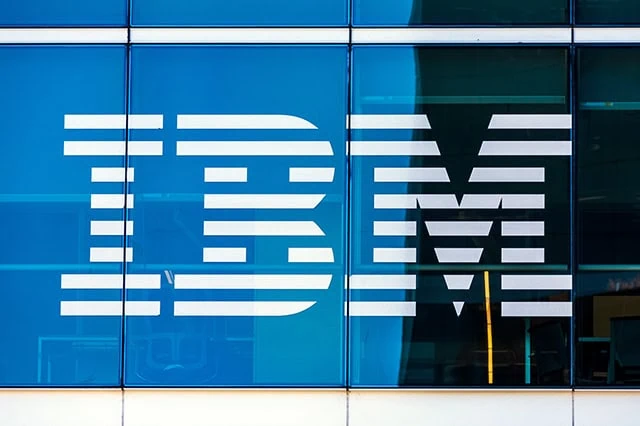Stocks are a winning proposition, historically speaking. You just need a little patience sometimes.
No one’s forcing you to invest in stocks. You can invest in just about anything else, in fact—shoes, artwork, properties, you name it—and years down the road, someone might want to buy that pair of Nikes or that Matisse for more than you paid. But the easiest case one can make is for investing in stocks, which are both ridiculously simple to buy and have generated spectacular returns over the long haul.
Just consider a half-century’s worth of data showing how stocks have performed compared to a few other popular investment assets.
| Asset | Average Annual Return, 1975-2024 |
|---|---|
| S&P 500 Index (Stocks) | 12.26% |
| Baa-Rated Corporate Bonds | 8.62% |
| 10-Year Treasury Bonds | 6.05% |
| Gold | 5.42% |
| Real Estate | 5.28% |
| Source: NYU Stern School of Business | |
Stock investors who plunked a mere $1,000 in the S&P 500 back in 1975, and didn’t contribute another cent, would still have been sitting on $325,055 as of the end of 2024. That compares to just $62,438 for corporate bonds, $18,841 for 10-year Treasuries, just $13,076 for real estate, and a mere $12,649 for gold!
Yes, past performance has no bearing on future returns. But by their very nature, stocks have the potential for higher returns than many other assets, now and in the future—and the longer you hold, the more compounding can do the wealth-building work for you!
If you’re looking for a starting point for your own portfolio, look no further. Today, we’re going to show you our list of “forever stocks.” These are some of the best long-term stocks you can buy and hold for literally decades down the road, and possibly even pass on to your heirs. They have collectively outperformed the market by a substantial amount in both medium- and long-term time frames, and as I wrote this, they were just a couple weeks away from topping the S&P 500 for full-year 2025.
Disclaimer: This article does not constitute individualized investment advice. Securities, funds, and/or other investments appear for your consideration and not as personalized investment recommendations. Act at your own discretion.
Why You Should Invest in the Stock Market

Stock represents a piece of ownership in a company. It allows you to profit from a company’s success—most commonly, when the price of your shares goes up, but in many cases, also from cash distributions (dividends) the company makes to shareholders. And the case for owning them is clear:
- Stocks have higher rates of returns than just about any other asset class.
- They can be held in numerous types of investment accounts.
- They’re easier to understand than many other types of investments.
If you ask us, investment funds—whether they’re mutual funds, exchange-traded funds (ETFs), or closed-end funds (CEFs)—are the simplest and easiest ways to invest in the stock market.
But individual stocks play an important role, too. The best long-term stocks offer investors a way to stay intellectually “invested”—by compelling people to stay up-to-date on companies they believe in. Plus, they provide investors with the potential to outperform those funds.
Bottom line: Whether you hold stock funds or individual equities, stocks (as an asset class) are among the best long-term investments you can make.
Growth Stocks or Value Stocks?
Growth stocks are generally considered to be companies that are expanding sales (and often profits) at a faster-than-average clip. Typically, growth companies have either an attractive product they are bringing to new markets or a steady drumbeat of new items they can sell to existing customers to open up new revenue streams.
Technology companies are typically the most common example of growth stocks, as they bring new gadgets to market that are better or faster than previous products.
Value stocks, on the other hand, are generally considered to be companies that trade for less than some sort of intrinsic value. They might not be expanding rapidly, but they often have a strong underlying business. Think of a local bank or a utility company that might have trouble doubling in size over the next few years, but doesn’t face a lot of competition or disruption to its business model. These companies are still capable of some growth—but Wall Street sometimes undervalues these firms, and their prices can improve once other investors catch on to their true value.
You can find the best long-term stocks hiding out in both camps. Reliable growth can result in significant gains over many years; alternatively, a rock-solid value stock will most commonly weather any market disruptions much better than a company that relies on enterprise spending trends or consumer confidence to drive its sales.
What About Dividend Stocks?
Dividend stocks (which commonly are value stocks, but can be growth stocks) are great ways to drive long-term performance of your portfolio. These companies pay a regular flow of their profits directly back to shareholders, meaning you receive some sort of return regardless of the ebb and flow of share prices.
Stocks that can both grow and pay dividends are the ultimate long-term stocks given just how much in additional returns they can generate over the long term.
Here’s a look at the return someone could expect if they received just the price returns from the S&P 500 over the past 25 years:

Now look at how much better the return is when you factor in dividends had you had reinvested those dividends back into the S&P 500 (returns illustrated by an S&P 500-tracking ETF; note that expenses are included in performance):

The price return is right around 400%. The total return (price plus dividends) is a hair over 680%!
The best long-term stocks tend to be companies that aren’t overly dependent on specific trends in the global economy, and companies that can deliver returns in any environment. Dividend growth stocks (companies that pay larger dividends over time) tend to check both those boxes, proving they have operations that generate significant profits, and are growing those profits enough to deliver larger paydays to shareholders each year.
Stock picking help by Motley Fool Stock Advisor
- Motley Fool Stock Advisor is a stock service that provides recommendations for both "steady Eddie" and high-flying stocks, as well as a few ETFs for investors who want diversified holdings, too.
- Just getting started? Stock Advisor provides 10 "Foundational Stocks" you can use to anchor your portfolio.
- You're not alone! Stock Advisor membership also gives you access to a community of investors who also want to outperform the market and love talking shop.
- Enjoy access to GamePlan: Motley Fool's financial planning hub, which includes advice on personal finances, taxes, retirement, and more, as well as calculators and other financial tools.
- Limited-Time Offer: Get your first year with Stock Advisor for $99 (vs. $199 usual value)—a 50% discount for new members!
- Discounted introductory price
- Strong outperformance above S&P 500
- High overall average return for stock picks
- High renewal price
- Not every stock is a winner
Related: 15 Best Investing Research & Stock Analysis Websites
What’s a Diversified Portfolio?
The best long-term stocks are part of an investment strategy that prioritizes stability and risk management over risky short-term bets that might pay off—or leave you in tears.
There are plenty of investment strategies that, after the fact, look wise simply because they worked out. But your personal financial situation matters. Ask yourself this: Would you bet $10,000 on a 50/50 chance of either doubling that money or losing every penny instantly?
If your answer is “no,” then there are certain strategies you should never consider in your toolkit, and others you should stick with even if it means your returns are not as dramatic.
One low-risk strategy that many investors deploy is the notion of a diversified portfolio that spreads your risk around in multiple vehicles. The easiest way to do that is through mutual funds and ETFs, which hold dozens if not hundreds or even thousands of stocks, bonds, and other assets. And you can keep your costs down by purchasing index funds—mutual funds or ETFs managed not by humans, but effectively a rules-based algorithm.
However, you can also look beyond the typical offerings out there and build your own diversified portfolio by hand-picking a basket of long-term stocks.
If you want more control or customization in your portfolio, there’s nothing wrong with picking individual stocks—in fact, it often makes sense to put a few individual stocks alongside the mutual funds and/or ETFs in your portfolio.
Just make sure you’re doing your research to ensure you have the best stocks available, and that you are keeping an eye on diversification.
Do you want to get serious about saving and planning for retirement? Sign up for Retire With Riley, Young and the Invested’s free retirement planning newsletter.
Related: How to Get Free Stocks for Signing Up: 9 Apps w/Free Shares
The Best Long-Term Stocks to Buy and Hold

If you’re looking beyond mutual funds and ETFs to build your own portfolio of the best long-term stocks, it’s crucial to both understand your personal investing goals as well as to do your own homework before buying (and selling!) an individual company’s shares.
That includes looking at stocks for specific strengths, like their market share or their annual earnings trends compared with their peers, as well as how a given stock performs against the broader market at large.
There’s no one-size-fits-all approach to anything on Wall Street, so you should always look at the latest numbers and do your own personal analysis before making any trades. But to get you started, here is our updated list of standout companies that are among the best long-term stocks to buy based on share performance, earnings trends, staying power, and other factors.
Stocks are listed by dividend yield, from lowest to highest.
Best Long-Term Stock #15: Amazon

- Sector: Technology
- Market capitalization: $2.4 trillion
- Dividend yield: N/A
Amazon (AMZN) is a one-stop shop for nearly anything you could want. The e-commerce storefront has redefined the customer experience, as has its two-, one-, and even same-day shipping.
But Amazon is so much more than just an internet shop.
Amazon is also the world’s biggest cloud provider through AWS, it’s an entertainment company through its Amazon Prime service, and it’s one of the biggest advertising companies, behind only giants Google and Facebook. AMZN makes for such an attractive stock because it’s supported by a diversified business with ample opportunities to enter new markets and disrupt well-seated industry incumbents.
That said, the optimism about future growth is mostly centered around AWS, cloud, and the potential growth AI could deliver. The company is investing deeply in both AI development and infrastructure—it has even created its own silicon, including the Graviton, Trainium, and Inferentia chips—and Wall Street largely believes these bets are going to continue paying off.
“AWS appears to be leveraging its leading market share in cloud to become a major player in the AI space, via internal architectures such as Amazon Bedrock, foundation models such as AWS Trainium and AWS Interfentia, and partnerships with Anthropic, Meta, and others,” says Argus analyst Jim Kelleher. “CEO Andy Jassy reiterated that AI is growing three times faster than cloud at this stage of its development, and Amazon is investing aggressively to capture this growth.
“The Project Ranier supercomputer, powered by nearly 500,000 Trainium 2 chips, is now live and could represent a monumental forward for AWS’ AI development. Trainium is now a multi-billion dollar business that grew 150% sequentially in 3Q25, according to CEO Andy Jassy.”
Amazon is a rarity among long-term stocks to buy and hold forever in that it doesn’t pay a dividend—not a penny. For now, much of the company’s spectacular cash flow is being reinvested in ways to either improve what it has or grow into still further business lines. What isn’t spent is being stashed away in AMZN’s nearly $100 billion rainy-day fund—at the very least, the ultimate financial security blanket for Amazon, but also dry powder for further investments, transformative M&A, or at some point, shareholder rewards.
Best Long-Term Stock #14: Alphabet

- Sector: Communication services
- Market cap: $3.6 trillion
- Dividend yield: 0.3%
Alphabet (GOOGL) is another multitrillion-dollar member of the Magnificent Seven that’s worth buying and holding for a very long time. It’s a digital advertising powerhouse that not only provides the go-to search engine for most Americans, but also the infrastructure to serve display ads across all manner of content.
Part of that infrastructure looked to be in danger. The U.S. Department of Justice said it wanted to break up Google on antitrust concerns—specifically, it wanted the firm to spin off its Chrome web browser, and ensure Android won’t favor its own search engine. But a 2025 ruling spared Google from the harshest of penalties; Google will have to share search data with its rivals, and while it will be able to continue paying companies to load its products on software, it won’t be able to have exclusive contracts.
No wonder Wall Street remains wildly bullish on this communication services mainstay.
“We believe that Google not being forced to sell Chrome or Android is the biggest win of the ruling,” says Truist Managing Director Youssef Squali. “Chrome is invaluable to Google given its dominant market share of the web browser market. Chrome has been the glue for Google to cross-sell other products and collect data, and could increasingly be a way for Google to distribute its emerging AI agents through plug-ins once it starts commercializing them.”
Another sign of expert confidence? In late 2025, Berkshire Hathaway (BRK.B) disclosed a $4.3 billion stake in Alphabet, making it the holding company’s 10th largest position.
“We believe the move validates GOOG’s strong fundamentals and provides Berkshire exposure to a leading AI provider through Google Cloud and Gemini expansion,” CFRA analyst Angelo Zino says. “The endorsement likely bodes well from an investor confidence perspective. We think Berkshire likely finds more comfort investing in GOOG over other tech plays given the high free cash flow potential of its core business coupled with an attractive valuation at about 22x 2027 EPS amid a healthy top-line growth trajectory.”
Alphabet’s revenues have grown every year for a quarter-century, but the company isn’t resting on its laurels. Google is integrating its AI-powered assistant, Gemini, into its core services, including its ubiquitous search engine—and importantly, it’s figuring out how to reduce costs of running queries. Meanwhile, its Google Cloud services continue to expand at a rapid clip, and it has doubled down on cybersecurity with a $32 billion deal to buy Wiz.
Alphabet even initiated a dividend in April 2024, then announced its first dividend hike a year later. Sure, it’s just a 21¢ payout that translates into a sub-1% yield. But Alphabet is a cash-generation machine, which bodes well for future payout growth … and every dividend has to start somewhere.
Editor’s note: GOOGL is the ticker for the company’s Class A shares, which have voting rights. Alphabet’s Class C shares, with the ticker GOOG, are also available to regular investors but have no voting rights.
Make Young and the Invested your preferred news source on Google
Simply go to your preferences page and select the ✓ box for Young and the Invested. Once you’ve made this update, you’ll see Young and the Invested show up more often in Google’s “Top Stories” feed, as well as in a dedicated “From Your Sources” section on Google’s search results page.
Related: 8 Best Stock Portfolio Tracking Apps [Stock Portfolio Trackers]
Best Long-Term Stock #13: Constellation Energy

- Sector: Utilities
- Market cap: $107.7 billion
- Dividend yield: 0.4%
When it comes to the best long-term stocks, the utility sector stands out as a natural place to look.
For starters, utility companies always have “wide moats,” which is a way of saying they have significant, established advantages that make it difficult to compete. Utilities are exceedingly capital-intensive businesses that are highly regulated, and thus competition is very difficult to come by—in fact, in many cases, U.S. utilities are de facto regional monopolies. Furthermore, electricity is a necessity for businesses and consumers that sees strong baseline demand even in a rough economic environment. That creates a measure of certainty for the sector, regardless of broader uncertainty or economic cycles.
If you’re looking for long-term investments, then, utilities are a natural choice. And in this sector, Constellation Energy (CEG) stands out as one of the larger and better-performing options in the sector.
Constellation is among the largest utility stocks on Wall Street. Based out of Baltimore, it sells natural gas and electricity service, with about 32,400 megawatts of generating capacity—enough to power 16 million homes and businesses. It also produces a variety of carbon-free energy, including wind, solar, hydroelectric, and nuclear.
While one doesn’t typically associate utilities with growth, CEG has delivered a total return of nearly 890% since being spun off from Exelon (EXC) at the beginning of 2022. The utilities sector is up less than 50% over the same period. Its latest potential source of upside? The tech sector. In 2024, for instance, Constellation signed a 20-year power purchase agreement with Microsoft (MSFT) that will involve the restart of Three Mile Island Unit 1, as well as the launch of the Crane Clean Energy Center. And in summer 2025, it made a similarly long agreement with Meta Platforms (META) to support the Facebook parent’s energy needs.
CEG also boasts the largest fleet of nuclear plants in the U.S., which puts it in a great position amid President Donald Trump’s executive orders aiming to jump-start the nuclear industry.
At whatever point the dust settles and CEG isn’t quite as “growthy,” you can expect the company to be able to foot a healthy dividend. The current yield isn’t nearly so generous as other utility stocks out there, but distributions are already 175% higher than they were post-spinoff.
Related: 11 Best Stock Trading Apps [Free + Paid]
Best Long-Term Stock #12: Eli Lilly

- Sector: Health care
- Market cap: $940.1 billion
- Dividend yield: 0.6%
If you’re building a wish list of long-term stocks to buy and hold, Eli Lilly (LLY) certainly belongs—if not to buy the stock itself, then at least as an illustration of what you should be looking for. That’s because pharmaceuticals are a portfolio mainstay—hundreds of millions of people worldwide rely on pharma firms’ treatments, and countless investors lean on these stocks as a source of both growth and income.
Eli Lilly was founded nearly 150 years ago in Indianapolis, by Col. Eli Lilly—a Union Army veteran! It gained fame for introducing the world’s first commercial insulin roughly a century ago, and while its product lineup has certainly broadened since then, it remains a leader in diabetic treatment.
Lilly’s lineup includes cancer treatments Verzenio and Erbitux, as well as autoimmune injectable Taltz and migraine prevention drug Emgality. And its diabetes lineup includes well-known drugs such as Trulicity, Jardiance, and Humalog. But leading the way forward are two products—Mounjaro and Zepbound—that belong to a rising class of drugs: glucagon-like peptide-1 (GLP-1) receptor agonists, which help manage blood sugar levels in people with Type 2 diabetes. While that’s certainly reason enough for the drug to exist, it also serves another purpose: being an extremely effective way for patients to battle obesity. Already, these two drugs have become “blockbusters” (drugs that generate more than $1 billion in revenue in a year), and Wall Street analysts only expect demand for these and similar products to rise going forward.
But Lilly isn’t stopping there:
“The company … recently announced positive results from several studies evaluating orforglipron, an oral small molecule GLP-1 receptor agonist, in patients with type 2 diabetes, as well as in patients with obesity, or overweight with a weight-related medical problem and without diabetes,” Argus Research analyst Jasper Hellweg says. “Given the compelling results of these studies, Lilly plans to submit orforglipron for the treatment of type 2 diabetes to global regulatory agencies in 2026, while submission for the treatment of obesity is on track to occur by the end of the 2025 year.”
A sub-1% yield might not indicate that Lilly is income-friendly, but that’s largely an effect of LLY’s share price rising so fast. In fact, management has been pouring increasingly large gobs of its newfound cash into the dividend for years. Most recently, LLY announced a 15% dividend increase, to $1.50 per share, to take effect starting with the March 2025 payout. Not only is that the company’s 11th consecutive dividend hike, but it’s the seventh straight raise of 15%. (And LLY has paid a dividend since 1972.)
By the way: That cash distribution represents only about a quarter of 2025’s expected earnings—an extremely healthy ratio that signals more potential for dividend increases going forward.
While Lilly has long been a productive pharmaceutical stock, it has been launched into a new tier. It is now the biggest pharmaceutical company on U.S. exchanges, and increasingly appears worthy of being called a long-term buy-and-hold stock. If nothing else, it’s a representative example of the kinds of companies investors should consider when their holding time is measured in years, and not just a few months.
Related: 10 Monthly Dividend Stocks for Frequent, Regular Income
Best Long-Term Stock #11: Costco Wholesale

- Sector: Consumer staples
- Market cap: $384.7 billion
- Dividend yield: 0.6%
Retailers are difficult to rely on as buy-and-hold investments because they tend to be subject to broader spending trends and changing consumer tastes. Not to mention, predominantly brick-and-mortar retailers are anything but a sure thing in this age of e-commerce.
However, warehouse retailer Costco Wholesale (COST) is still worth a look as a long-term holding, since its unique model sidesteps most of these concerns.
For starters, the chain operates more than 900 warehouses worldwide, with about two-thirds here in the U.S. It appeals to bargain shoppers and the staples it sells typically have low margins, but it also has a regular membership fee that generates a ton of baseline cash every year. Costco boasts nearly 140 million cardholders in the U.S. alone—and at a recently raised $65 per household (and even pricier business memberships), that creates a tremendous foundation for this retailer.
What’s more, the company’s customers are true believers in its value-conscious offerings, and there’s a veritable cult of followers behind Costco’s Kirkland Signature store brand. And if times get tough, even more customers might end up walking through the warehouse looking to save on their groceries and household goods as they pass over Costco’s competitors.
A low-cost approach might not set the world on fire, but providing affordable offerings to loyal customers is a pretty consistent business model.
Related: 15 Best Stock Research & Analysis Apps, Tools and Sites
Best Long-Term Stock #10: Microsoft

- Sector: Information technology
- Market cap: $3.5 trillion
- Dividend yield: 0.8%
When it comes to stocks with scale and staying power, Microsoft (MSFT) is another tech giant that immediately springs to mind. The technology firm is synonymous with workplace productivity, with its Windows and Office 365 software products—now bolstered by Microsoft’s Copilot AI chatbot—the gold standard for businesses around the world.
Microsoft isn’t without growth plans despite its already impressive scale, however. Its Azure cloud computing business continues to expand at a rapid clip, its remote workplace tools like Teams have now become hardwired into enterprise operations in the wake of the pandemic, its artificial intelligence run rate is on track to surpass $10 billion in 2025, and its Xbox video game arm is a juggernaut in its own right.
So, a growth stock? Yes. But a defensive stock? Also yes.
“Although not immune to macroeconomic challenges (such as declines in the PC original equipment manufacturers (OEM) market and in digital advertising), Microsoft has about as diversified and strong a set of assets as any company in the technology industry—and may even be seen as a safe haven by investors in uncertain times,” says Argus Research analyst Joseph Bonner. “The company is one of a few names with a complete, integrated commercial product set aimed at enterprise efficiency, cloud transformation, collaboration, and business intelligence. It also has a large and loyal customer base, a substantial cash cushion, and a rock-solid balance sheet.”
With long-term investing, it’s all about trying to find certainty in an uncertain world. And the dominance of Microsoft seems incredibly likely regardless of geopolitics, economic cycles, or anything else. Microsoft is one of the 25 largest corporations in the world as measured by revenue, and it has been among the three largest in market capitalization for years. And despite being tech company with a lot more growth left in the tank, it also offers a modest but rising dividend.
If you want stability and scale in a long-term stock investment, Microsoft is it.
Related: 7 Best Fidelity Retirement Funds [Low-Cost + Long-Term]
Best Long-Term Stock #9: Moody’s

- Sector: Financials
- Market cap: $89.3 billion
- Dividend yield: 0.8%
Moody’s (MCO) is a global risk management firm that is best known for providing credit ratings. That includes credit scores for individual consumers as well as “official” rankings for major corporations and governments—including the United States, via its rating on U.S. Treasury debts. Additionally, the company also offers investor services that includes research and data to arm investors with information to make the best decisions.
In early 2025, Moody’s announced a 10%-plus increase to its payout, to 94¢ per share. Consider that in 2014, it paid just 34¢ per share—meaning over the last decade, MCO has increased its payouts by more than 175%. That’s part of a broader long-term trend of growth and success, too, with revenue that has surged from $4.8 billion in fiscal 2019 to a projected $7.7 billion for fiscal 2025—representing several upgrades from earlier estimates for about $7.1 billion.
The structure of the current financial system all but guarantees that consumers and businesses will need to go through Moody’s to get their seal of approval for loans. And given the history of revenue expansion and dividend growth in recent years, there’s good reason to bank on Moody’s delivering in the years ahead.
Related: Best Investment Apps and Platforms
Best Long-Term Stock #8: Linde plc

- Sector: Materials
- Market cap: $197.4 billion
- Dividend yield: 1.4%
Materials stocks don’t often make the cut for most lists of long-term investments. They’re cyclical investments that tend to rise and fall based on broad-based economic trends and industrial demand. That said, with a little bit of research and a lot of patience, investors can still find high-quality companies in this space that are positioned to withstand the test of time.
Case in point: Ireland-based Linde plc (LIN).
Linde is the world’s largest industrial gas producer, offering oxygen, nitrogen, argon, helium, hydrogen, electronic gases, acetylene, and rare gases. It also produces air separation, synthesis, olefin, and other plants for third-party customers. And it does this across every continent.
While this is certainly a cyclical business, Linde offers some shelter from the economic shocks that many of its businessmates suffer. That’s in part because of its diverse offerings, but also because of the industries it supplies, which includes defensive industries such as health care and food/beverage. Most of its contracts are with blue-chip firms, too, and that keeps the cash flowing.
In fact, its business has been so relatively stable that it has—by virtue of its 2018 merger with fellow gas giant Praxair—been able to deliver 32 consecutive years of increased dividends to its shareholders. That puts it among the ranks of the Dividend Aristocrats—an elite group of a few dozen dividend payers that have raised their payouts for at least 25 straight years.
So while long-term buy-and-holders might look away from the materials sector, Linde sticks out as a surprisingly stable “forever stock.”
Do you want to get serious about saving and planning for retirement? Sign up for Retire With Riley, Young and the Invested’s free retirement planning newsletter.
Best Long-Term Stock #7: BlackRock

- Sector: Financials
- Market cap: $167.1 billion
- Dividend yield: 2.0%
BlackRock (BLK) is one of the world’s largest asset management firms, boasting more than $13 trillion in assets across its many lines of business. Individual investors know it well for both its BlackRock mutual funds and closed-end funds (CEFs), as well as its iShares exchange-traded funds (ETFs). But it also manages money for institutional clients, including pension plans, foundations, charities, and insurance companies, among others.
With the exception of a few understandable hiccups (COVID, for instance), BlackRock has been in a broader consistent uptrend since the depths of the Great Recession. That has come alongside similar progression in both the company’s top and bottom lines.
It’s difficult to find any Wall Street pros with something negative to say about BLK. Shares currently enjoy 13 Buy calls versus three Holds and no Sells, and the analysts’ consensus for long-term earnings growth sits at an encouraging 12% annually.
“We believe that BLK remains well positioned to deliver above-peer organic growth given its unmatched product breadth and distribution footprint (helped by its iShares franchise),” say Keefe, Bruyette & Woods analysts Aidan Hall and Kyle Voigt. “Also, its scale and demonstrated ability to generate operating leverage bodes well for future earnings growth and operating leverage.”
BlackRock has been a fount of dividend growth since the Great Recession, too. In the past decade alone, BLK has managed to average 10% annual dividend growth, though that pace has been slowing in recent years—its most recent hike, announced in January 2025, was a mere 2% bump to $5.21 per share. Still, a payout ratio around 45% should keep investors plenty confident in the dividend’s health and its ability to keep growing.
Related: 5 Best Vanguard Dividend Funds [Low-Cost Income]
Best Long-Term Stock #6: FedEx

- Sector: Industrials
- Market cap: $66.5 billion
- Dividend yield: 2.1%
FedEx (FDX) is another cyclical business—one whose shares have slumped several times in the past quarter-century. And yet, it has still been a model of buy-and-hold-worthiness.
Yes, FedEx’s logistics business is cyclical, as package volume tends to rise and fall based on broader spending trends. But there’s a long-term megatrend lifting this stock that cannot be overlooked. And if you look around the front porches in your neighborhood, you’ll probably find proof of this trend yourself via all the boxes lying around.
In the age of Amazon and e-commerce, FedEx is about as safe a bet as you can make. Yes, it’s not quite as large as competitor United Parcel Service (UPS), but it’s still a massive and valuable part of the global supply chain.
FedEx has paid dividends since 2002, but over the past few years, it has really stepped up its efforts to share the wealth with stockholders. Its cash distribution has jumped by almost 125% since 2021, including a 5% increase announced in mid-2025. Meanwhile, that dividend represents just 30% of 2025’s projected earnings, making the payout not just sustainable—but plenty expandable. FDX also spent $3 billion in share repurchases during its fiscal 2025, which ended May 31.
Just more reasons why FDX is among the best long-term stocks to buy and hold.
Related: The 13 Best Investment Apps for Beginners
Best Long-Term Stock #5: International Business Machines

- Sector: Technology
- Market cap: $285.8 billion
- Dividend yield: 2.2%
International Business Machines (IBM) is one of the oldest technology companies in the world, with roots going back to its founding in 1911 as the “Computing-Tabulating-Recording Company.”
The business has changed a touch in the century-plus since. A company that once sold record-keeping and measuring systems is now a global giant dealing in enterprise information-technology hardware, software, and services. Its predominant offerings revolve around hybrid cloud (an IT infrastructure meshing public cloud, private cloud, and on-premises equipment), artificial intelligence, and consulting. And its clients and partners are a who’s who of the technology world, including Microsoft, Salesforce (CRM), Samsung, Oracle (ORCL), Adobe (ADBE), and more.
IBM hasn’t always been on the bleeding edge of technology—it was notoriously slow to pivot from hardware to the cloud. But it’s no dinosaur, either. For instance, IBM is viewed as having potential in quantum computing, which itself is a long-awaited accelerant for artificial intelligence. Moreover, it’s an entrenched and long-trusted giant that will seemingly always have a place as long as the business world needs new tech.
The company is also growing by acquisition, recently announcing it would buy data streaming company Confluent for $11 billion. “IBM historically gets optimal leverage from targets that have challenges penetrating large enterprises and significant potential cost synergies,” Stifel analysts say.
IBM is a buy-and-hold-forever stock because of its income history, too. “Big Blue” has paid dividends without interruption for more than a century. And it has also increased that distribution annually for 30 consecutive years (the latest, a modest bump in April 2025), giving it Dividend Aristocrat status.
Related: 7 Best Stock Portfolio Management Software Tools + Apps
Best Long-Term Stock #4: Lockheed Martin

- Sector: Industrials
- Market cap: $109.7 billion
- Dividend yield: 2.9%
For better or for worse, defense giant Lockheed Martin (LMT) seems like one of those companies that will always have a sound financial foundation thanks to its focus on military matters and close relations with the U.S. Department of Defense.
Lockheed and its iconic “Skunk Works” developed many of the Cold War-era jets and missile systems that have become synonymous with modern military might. More recently, conflicts like those in Ukraine and Gaza have sparked an increase in spending on its drone and missile defense operations. And it’s worth noting that for LMT’s clear domestic ties, international sales now make up more than a quarter of revenues, providing much-needed geographic diversification.
The for-profit nature of our military industrial complex might not sit well with some investors. But presuming you have no moral qualms about the kind of business LMT is in, this is definitely a long-term investment to consider because its business isn’t driven by consumer spending or even enterprise spending the way tech companies or apparel companies are. Instead, it’s driven by long-term contracts—and the long-term need for security amid geopolitical unrest.
This dynamic has helped Lockheed become a powerful dividend payer, too. In October 2025, LMT raised its payout by 4.5%, to $3.45 per share quarterly, marking its 23rd consecutive distribution hike.
Related: 11 Best Stock Advisor Websites & Services to Seize Alpha
Best Long-Term Stock #3: Bunge Global

- Sector: Consumer staples
- Market cap: $16.3 billion
- Dividend yield: 2.9%
Bunge Global (BG) is a leading agribusiness and food company, operating across the entire agricultural supply chain through its many subsidiaries. All told, its operations span roughly 23,000 employees across more than 300 facilities in over 40 countries.
The U.S.-headquartered but Switzerland-incorporated firm is a leading global oilseed processor and producer of vegetable oils and protein meals. It sources, processes, and distributes grains such as soybeans, wheat, and corn. It produces agricultural products such as fertilizers and sugars. And that’s just some of what this ag giant does.
Bunge has been a “patience stock” for years thanks to lower margins on crush (the process that produces soybean oil and protein meal), as well as delays to its proposed mega-acquisition of Canadian grain handling business Viterra. However, investors who have had patience are finally seeing the payoff, with the stock up 20% as of mid-December amid optimism over renewable volume obligation (RVO) and the closing of its Viterra deal.
“[Bunge] reiterated 2025 EPS guidance of ~$7.75 (ex Viterra) including $0.10 impact from corn milling business divestiture, with Q3 below consensus and Q4 above,” says BMO Capital Markets Analyst Andrew Strelzik, who rates the stock at Outperform. “We believe BG remains an attractive opportunity given negative sentiment and historically depressed multiple on our estimate of potential 2026 pro forma EPS of $9 to $10, from which BG can grow.”
The analyst camp is solidly in Bunge’s bull camp, with seven Buys versus two Holds and no Sells.
Bunge, meanwhile, can pay investors at least a modest sum for their patience. The nearly 3% yield, on a quarterly dividend of 70¢ per share, is close to 2 percentage points better than what you’ll get from the S&P 500. That dividend has also grown by a decent 33% over the past four years, and it’s as safe as you could want it, with Bunge maintaining a conservative payout ratio of 30% of 2026 profit estimates.
Related: 6 Best Stock Recommendation Services [Stock Tips + Picks]
Best Long-Term Stock #2: Prologis

- Sector: Real estate
- Market cap: $118.8 billion
- Dividend yield: 3.2%
Real estate is often seen as a store of value for many long-term investors, and for good reason. In the words of Mark Twain, “Buy land, they’re not making it anymore.”
That simple truth makes Prologis (PLD) a great long-term stock to consider because of its portfolio of specialized properties in key markets around the world.
This real estate investment trust (REIT) is a global leader in logistics real estate with a focus on high-barrier, high-growth markets. Indeed, PLD and its warehouses are a key part of the world’s supply chain. Prologis owns and/or operates 1.3 billion square feet across 20 countries. Top clients include Amazon and FedEx, making these properties must-have hubs for distribution, but they’re just part of a diverse base of more than 6,500 customers largely in business-to-business distribution and retail fulfillment.
With projected revenue growth in the high single digits for both 2025 and 2026, PLD is ramping up operations to become even more dominant in the years ahead. Dividends are now about three times what they were a decade ago; 2025 distributions of $1.01 per share were 5% better than they were in the year prior.
It’s hard to imagine any upstart firm acquiring enough property quickly enough to compete with Prologis in the years ahead. And while spending trends wax and wane, the long-term nature of PLD leases with first-class corporations means its finances (and its dividend) are very secure for the foreseeable future.
Related: 11 Best Stock Screeners & Stock Scanners
Best Long-Term Stock #1: Plains All American Pipeline, LP

- Sector: Energy
- Market cap: $12.4 billion
- Distribution yield: 8.7%*
It’s no easy task to identify energy stocks with staying power in this age of climate change. However, one of the most stable stocks in the space is “midstream” energy company Plains All American Pipeline, LP (PAA).
Although it’s one of the smaller stocks on this list, and much smaller than multinational Big Oil leaders, it’s important to point out that PAA, while focused on crude, isn’t drilling for it. Instead, it’s an energy infrastructure company—one that’s operated as a partnership—that is focused on the capital-intensive nature of building pipelines, terminals, and storage facilities. This business model makes the company less volatile than energy exploration-and-production firms, or the various other energy stocks that are sensitive to market prices for petroleum products.
And its focus on crude is about to become sharper, as the company in mid-2025 agreed to sell its Canadian natural gas liquids business for $3.75 billion to midstream operator Keyera.
Plains All American Pipeline has been running terminaling, storage, and transportation infrastructure since its founding in 1981. It’s not a glamorous business, but it provides consistency that has helped to fuel a current distribution yield that’s around eight times the S&P 500 right now. That distribution is growing, too; the company kicked off 2025 by announcing a roughly 20% increase in its payout.
If you want to make a swing trade on oil prices, PAA is not for you. But if you’re looking to invest in a low-risk, income-oriented fashion across 2025 and well beyond, this energy infrastructure player might have a place in your portfolio.
* Distribution yield is calculated by annualizing the most recent distribution and dividing by share price. Distributions are like dividends, but they are treated as tax-deferred returns of capital and require different tax paperwork.
Want to talk more about your financial goals or concerns? Our services include comprehensive financial planning, investment management, estate planning, taxes, and more! Schedule a call with Riley to discuss what you need, and what we can do for you.
Frequently Asked Questions (FAQs)

Should I only invest in individual stocks?
Statistically speaking, it’s difficult for even professional investors to beat the market with their own stock picks. So as you’d imagine, it’s extremely difficult for everyday people to do the same. Typically, then, you’re best off holding a few individual stocks that interest you, and putting most of the rest of your investment money into diversified funds, such as mutual funds and exchange-traded funds (ETFs).
Mutual funds
When you buy a mutual fund, you’re giving money to a fund company that in turn buys investments—usually stocks and/or bonds. And when you want to sell, the company sells off whatever investments it must to raise the funds to make you whole.
These mutual fund companies typically charge fees (that pay for management and other expenses) that are taken straight out of the fund’s performance. And unless you’re buying the mutual fund within a 401(k), you’ll likely have to invest a certain minimum dollar amount at first—say, $1,000, $2,000, maybe even more.
Where mutual funds are a little odd is that, unlike stocks, they don’t trade throughout the day. Instead, all buying and selling of a mutual fund happens once per day, after the trading day is over.
Exchange-traded funds (ETFs)
Exchange-traded funds (ETFs) are similar to mutual funds in that they’re a pool of money that’s invested in various assets—stocks, bonds, commodities, and/or other types of investments.
But unlike mutual funds, ETFs trade just like stocks, on major exchanges, all throughout normal trading hours. That provides them with liquidity, which is great for traders or just anyone who wants to exit their investment immediately.
ETFs also have other advantages, including better tax-efficiency, and a wider selection of niche strategies compared to mutual funds. ETFs do have annual expenses, like mutual funds, but they don’t have sales loads and many other “extra” fees. And unlike mutual funds, there are no investment minimums—you can buy as little as one share (or less than one share, if your brokerage offers fractional shares).
Lastly, ETF fees—on average—tend to be cheaper than mutual funds, but that’s because most ETFs are index funds. Whereas actively managed funds are run by one or more humans that select stocks, index funds pick investments based on a set of rules and are effectively run by an algorithm. Because there aren’t human managers, index funds tend to cost lest to operate, and thus their expenses are typically lower.
Just remember: There are index mutual funds and actively managed ETFs, too. Always know what you’re buying.
Do all companies pay dividends?
Not all companies pay dividends. Some companies choose not to, while other companies cannot afford to.
As you can tell by this list, the best dividend stocks are normally slow-and-steady companies that have consistent operations. While it might be possible for a small software company or biotech firm to double its share price overnight, these companies rarely pay dividends because they don’t have much in the way of profits—and what they do have, they want to spend on other things, like research and development to continue growing.
How often do companies pay dividends?
The cycle of paying dividends is always different depending on the company. While it’s generally true that most U.S. corporations opt to pay their shareholders a dividend once per quarter, the dates aren’t fixed.
Specifically, one company might pay you on a January-April-July-October payment cycle while another opts for February-May-August-November.
Complicating things further, some companies pay dividends twice a year, some pay once a year, and some even pay “special” unscheduled dividends.
Are stocks affected by interest rates?
Yes! In multiple ways!
For one, as interest rates rise, the amount of interest paid on newly issued bonds tends to rise. When that happens, bonds (which are fairly stable, reliable investments) start looking more attractive compared to stocks (which have more potential but are riskier investments).
For instance, an investor who owns a bunch of 3% yielding dividend stocks might not look twice at a Treasury bond yielding 1%. But if that same bond started yielding, say, 5%, that’s a much more attractive proposition—even if that bond doesn’t have the same growth potential.
Also, rising interest rates make it more expensive for companies to fund their growth. Many companies will issue bonds to bring in much-needed dollars to pay for things like new equipment, research, and personnel. The goal: Make enough in profits from that growth that you come out ahead even after not just paying back the loans, but all that interest. But the greater the interest rate a company has to pay on its bond, the more difficult it is to come out ahead.
That’s why you’ll see, when the Federal Reserve raises its benchmark federal funds rate, stocks of corporations that borrow a lot to grow tend to take it on the chin.
What if I need help picking stocks?
Several stock picking services can help you build a portfolio, typically for an annual subscription cost. One of our favorites is Motley Fool Stock Advisor.
Motley Fool Stock Advisor

Motley Fool Stock Advisor is a stock picking service that espouses my favorite, plain-vanilla trading style: buy-and-hold. Fool analysts provide recommendations for both “Steady Eddies” and potential high-flying stocks with sound fundamentals—an ideal combination of holdings if you want to generate strong performance without risking extremely high volatility.
Importantly, Stock Advisor doesn’t just give you a list of tickers and call it a day—it also provides investment rationales and research for each pick to help educate you before you buy.
Stock Advisor stock picks have performed exceptionally well over the service’s 22-year existence. The service has made 190 stock recommendations that have historically delivered 100%+ returns.
The service charges a discounted rate for the first year and has a 30-day membership-fee-back period. Read more in our Motley Fool Stock Advisor review, or sign up for Stock Advisor today.
- Motley Fool Stock Advisor is a stock service that provides recommendations for both "steady Eddie" and high-flying stocks, as well as a few ETFs for investors who want diversified holdings, too.
- Just getting started? Stock Advisor provides 10 "Foundational Stocks" you can use to anchor your portfolio.
- You're not alone! Stock Advisor membership also gives you access to a community of investors who also want to outperform the market and love talking shop.
- Enjoy access to GamePlan: Motley Fool's financial planning hub, which includes advice on personal finances, taxes, retirement, and more, as well as calculators and other financial tools.
- Limited-Time Offer: Get your first year with Stock Advisor for $99 (vs. $199 usual value)—a 50% discount for new members!
- Discounted introductory price
- Strong outperformance above S&P 500
- High overall average return for stock picks
- High renewal price
- Not every stock is a winner
Related:










